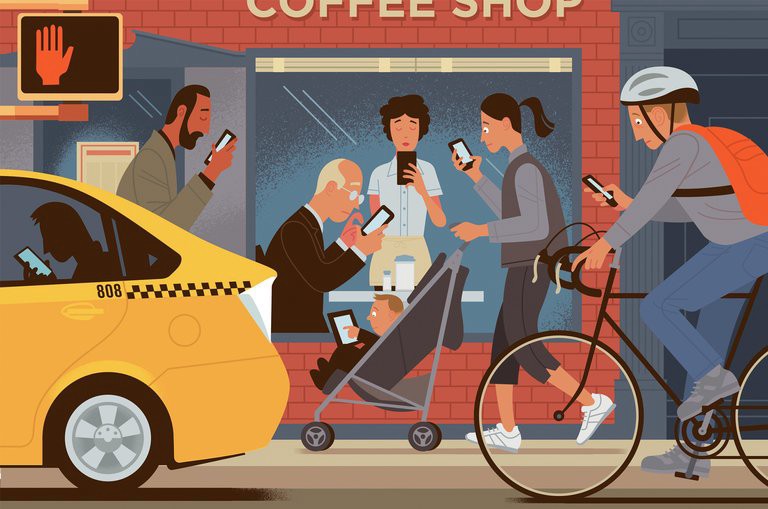Now that the smart nation terminology is in vogue after the National Day Rally speech, the local broadsheets are going to hone in ad nauseum. In fact, MOE is already at it saying they are going to introduce an e-learning portal in 2018. Stretching this a bit further, I want to talk about handphone use in classrooms.
e-learning from the teachers perspective
Pertaining to the e-learning initiative, let me decode what it means for students and parents.
The people from the top say digitize and do it.
Consequently, the bottom rung teachers on the ground scramble to make it happen abandoning the projects they are currently executing from the previous initiatives.
They do so because the new objectives are now part of their KPI and so is their performance bonus and promotion.
What does that mean to students?
As some of my students allude to, it’s a terrible idea.
These students come from a certain JC and who force their students to adopt 100% e-learning.
In doing so, their teachers just push their students to a half-baked portal and dump the entire material to the students.
And they assume students will be able to pick up themselves.
Nary a thought that A levels in Singapore is exceedingly difficult.
And that students at this stage need the most support and compassion in the trying times.
Unfortunately, e-learning to most teachers is just digitizing lessons and not structuring it in such a way as to enhance learning.
Technology creep into classrooms
As such, this requires much attention to the details of implementation. Not thinking through the use of technology in the classroom has severe consequences.
I was a technology evangelist in the classroom.
However, over the years seeing how student profiles change, I begin to think otherwise.
Haphazard adoption of technological tools just mean that students can now bring their handphone into the classrooms.
And with that, all the distractions of the handphones.
Handphone use in the classrooms: designing of addictive apps
One of the key metrics of app startups is app engagement.
The more engagement, the more data accumulates and the more valuable it becomes.
Facebook for example is not a social media company, it is a data re-seller.
As such, it is the responsibility of these companies to make their apps as addictive as well as sticky as possible.
And it is working isn’t it?

Unfortunately, as consumers of mobile apps, we begin to change biologically as well.
Handphone use in the classrooms: the addicted brain
One of the key ways to making the apps addictive is to have reminders that you need to open it up.
So there is notifications. And the app notifies you for the smallest things.
When you open up an app and clear away the notification, you get a quick bout of satisfaction. This is because the brain has just released a spurt of dopamine.
The feel good hormone.
Have you seen how we train dogs?
We give them treats to reinforce a desired behavior. And dopamine is that treat.
The most damning fact is that the more dopamine release, the more we want to do something and the vicious cycle begins.
Overtime, the brain rewires such that it responds more to short interruptions and it makes it harder to concentrate on tasks that requires long and deep attention.
Handphone use in the classrooms: counterproductive to learning
Guess what, learning requires long and deep concentration.
When the brain is exposed to new concepts, it takes a great effort as it tries to make sense of the concept.
This involves getting different neurons to make connections via nerve impulses. I liken it to the brain wanting to get from A to B and it is trying to get there. If B is not reached, one has not learnt.
Sometimes, this doesn’t occur so another route is used and over and over until one gets it (to B).
This is why learning takes time.
And this is the abject opposite behavior to the what handphone use in classrooms train.
Consequently, students don’t do well in exams because of this biological shift.
Handphone use in the classrooms: implementing airplane mode
In the case of dieting, the best way to avoid processed addictive and unhealthy foods is to remove it from homes.
To encourage optimal brain behavior for learning, handphones should either be removed or put in airplane mode.
Of course when that occurs, the pressure is on for the educator because the need to innovate the hell out of how they deliver their content.
To make it interesting, relevant enough to encourage the student to want to explore further.
Handphone use in the classrooms: bottom-line
Removing handphone use in the classrooms have been a difficult challenge.
Because this is akin to ‘cold turkey’ effects the students feel. And it adds on to the educator’s challenge how they deliver their content to keep attention up.
But once the students are weaned off the dependence of handphones in the classroom, they will become more effective learners.
The better the learning experience, the better the outcome and the final exams.
Finally, tell me if this has been useful.
Strategies for being a better student sitemap:
Study excellence
Developing Grit
Morning routine for A students
How to take good notes in class
Sleeping your way to optimal learning
Study productivity and diffuse learning
Foods that boost learning or exam prep
Positive thinking can help improve grades
10 tips for busy students to get more time
Handphone use in classrooms: how it works against learning
Exam Strategies
The exam diet
Boost A level performance
Goal setting for exam success
Solution to exam-taking anxiety
Spaced repetitions and exam success
How to remember everything for exams
Find motivation during exam preparation